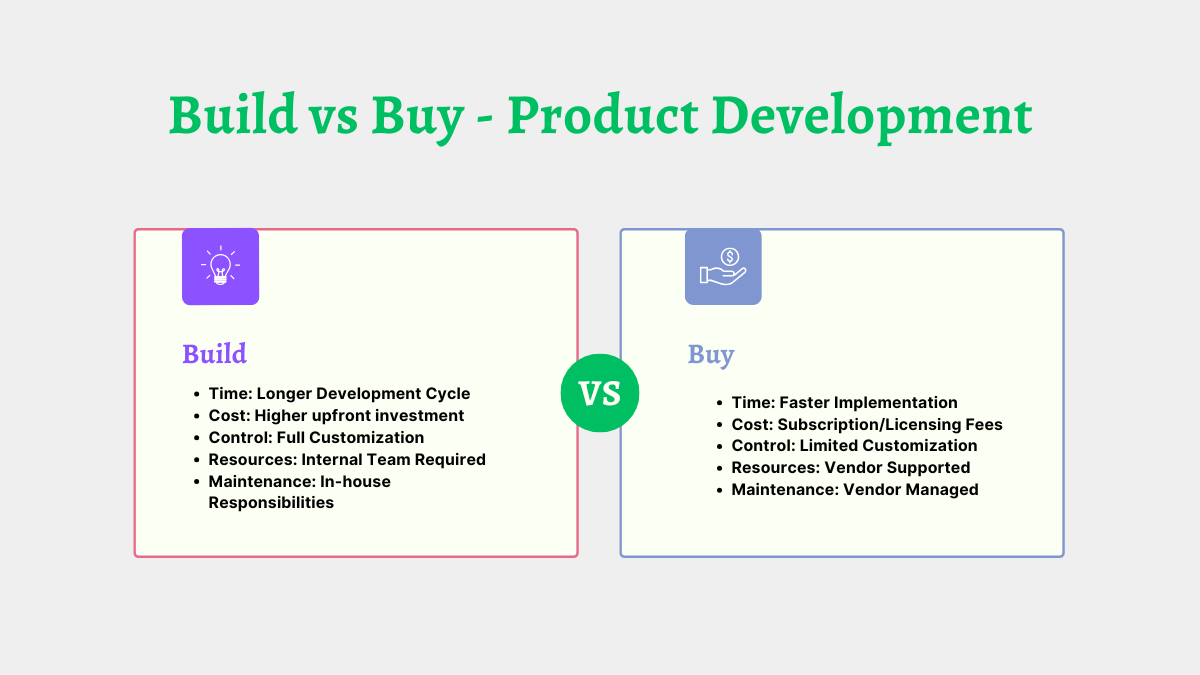The Build Option (In-House Development)
Explore the fundamentals of building solutions in-house, examining when this approach aligns with strategic goals. Analyze the resource implications and considerations that companies must weigh when choosing to develop internally. Consider how building in-house affects organizational dynamics, technical capabilities, and market positioning.
The Buy Option (Third-Party Solutions)
Examine the landscape of third-party solutions, including the evolution of the software/hardware component market. Discuss various purchasing models, from traditional licensing to modern subscription-based approaches. Address the nuances of integration and how third-party solutions fit into existing technical ecosystems.
Building vs Buying: Key Decision Factors
Strategic Alignment
Analyze how build vs. buy decisions must align with core competencies and contribute to competitive advantage. Examine the relationship between these decisions and long-term product vision, market positioning, and integration with existing systems. Consider how different choices affect organizational strategy and market differentiation.
Financial Considerations
Develop the in-depth analysis of the TCO (Total Cost of Ownership) for both build & buy, and make sure to add the development costs, maintenance requirements, training needs, licensing fees, and infrastructure demands. Explore ROI projections and risk assessment for both immediate and long-term financial implications.
The key components of TCO analysis:
- Development and Implementation Costs: Initial development expenses, team hiring and training, infrastructure setup, and implementation timelines
- Operational Costs: Ongoing maintenance, updates, support staff, and infrastructure running costs
- License and Subscription Fees: For buy options, including per-user costs, feature-based pricing, and volume discounts
- Hidden Costs: Integration expenses, employee training, potential downtime, and migration costs
Explore ROI projections and risk assessment, considering both immediate and long-term financial implications.
Technical Factors
Examine the technical considerations that influence build vs. buy decisions, including technology stack compatibility, scalability requirements, and customization needs. Address security considerations, integration complexity, and performance requirements. Discuss the implications of maintenance and updates under different scenarios.
Time-to-Market
Analyze how development timelines affect the build vs. buy decision, considering market windows, competitive pressures, and customer demand. Explore the relationship between resource availability and time-to-market goals. Discuss strategies for balancing speed with quality and sustainability.
Control and Flexibility
Examine the trade-offs between control and flexibility in both build and buy scenarios. Address customization requirements, regulatory compliance needs, and data ownership considerations. Explore vendor dependency risks and future adaptation capabilities.
Team Capabilities
Assess how team capabilities influence build vs. buy decisions, considering current skill sets, learning curves, and resource availability. Examine long-term maintenance implications and knowledge retention risks. Discuss strategies for capability development and team growth.
Decision Framework for Product Development
Assessment Phase
Detail the crucial steps in requirement gathering, including functional and non-functional requirements, business objectives, and constraints. Explain the importance of market analysis, including available solutions, vendor evaluation, and future trends. Describe methods for internal capability assessment.
Requirements Analysis
- Functional requirements and core features
- Non-functional requirements (performance, security, scalability)
- Business objectives and success criteria
- Technical and resource constraints
Market Evaluation
- Available third-party solutions
- Vendor reputation and stability
- Current market trends and future outlook
- Competitive landscape analysis
Evaluation Matrix
Present a structured approach to decision-making through evaluation matrices, explaining scoring criteria, weighting factors, and comparison methodologies. Provide guidance on establishing decision thresholds and interpreting results.
Primary Decision Criteria
- Strategic fit and alignment
- Total cost of ownership
- Implementation timeline
- Technical compatibility
- Risk factors
- Resource requirements
Scoring Methodology
- Weight assignment based on business priorities
- Quantitative and qualitative scoring approaches
- Threshold requirements and deal-breakers
- Comparative analysis techniques
Build vs Buy: Implementation Strategies
Build Strategy
Outline the key elements of successful in-house development, from project planning and resource allocation to risk management and quality assurance. Describe effective development processes, milestone definitions, and progress tracking methods. Address maintenance planning and knowledge transfer requirements.
Buy Strategy
Detail the process of vendor selection, including evaluation criteria, due diligence, and contract negotiation. Explore integration planning considerations and relationship management strategies. Discuss performance monitoring and contract renewal considerations.
Hybrid Approaches
Examine how organizations can combine build and buy strategies effectively through component-based decision-making and microservices architecture. Discuss API integration strategies and balanced resource allocation. Explore phased approaches to implementation and risk management.
Risk Management
Analyze the distinct risks associated with both build and buy decisions, including resource overruns, timeline delays, vendor stability, and integration issues. Present effective mitigation strategies and contingency planning approaches. Discuss the importance of regular assessments and adaptation protocols.
Case Studies
Present detailed analyses of successful build and buy implementations, examining decision factors, implementation processes, and outcomes. Include examples of failed projects, analyzing common pitfalls and lessons learned. Provide insights for avoiding similar challenges.
Future Considerations
Explore emerging technology trends and market evolution that may affect build vs. buy decisions. Discuss changes in vendor landscapes, pricing models, and service offerings. Address the organizational impact of different decisions, including skill requirements and cultural changes.
Decision Support Tools
Describe essential tools for decision support, including assessment templates, process frameworks, and evaluation matrices. Provide guidance on using these tools effectively within different organizational contexts.
Conclusion
Synthesize key insights and decision framework elements, emphasizing how successful build vs. buy decisions hinge on careful alignment between organizational capabilities, strategic objectives, and market realities. Examine how companies that excel in this decision-making process typically maintain a flexible approach, regularly reassessing their choices as technology evolves and market conditions change. Explore the growing trend toward hybrid approaches that combine the best aspects of both building and buying, allowing organizations to maintain competitive advantage while managing resources efficiently. Offer perspective on future trends, including the impact of emerging technologies like AI and cloud-native solutions on the build vs. buy equation, and provide final recommendations for approaching these decisions strategically in an increasingly complex technological landscape.
